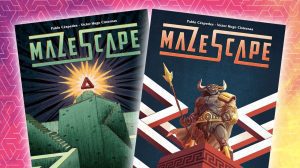Disclosure: Meeple Mountain received a free copy of this product in exchange for an honest, unbiased review. This review is not intended to be an endorsement.
In Shapers of Gaia (Wizkids, 2023), up to three players take on the role of Shapers who work with the Caretaker robot to restore a planet with biomes and populate them with animals. You’ll place tiles, collect and pay resources, and place animals from your player board to unlock unique abilities. Collect more Prestige than your opponents and you’ll join the Caretaker as a permanent guardian of Gaia.
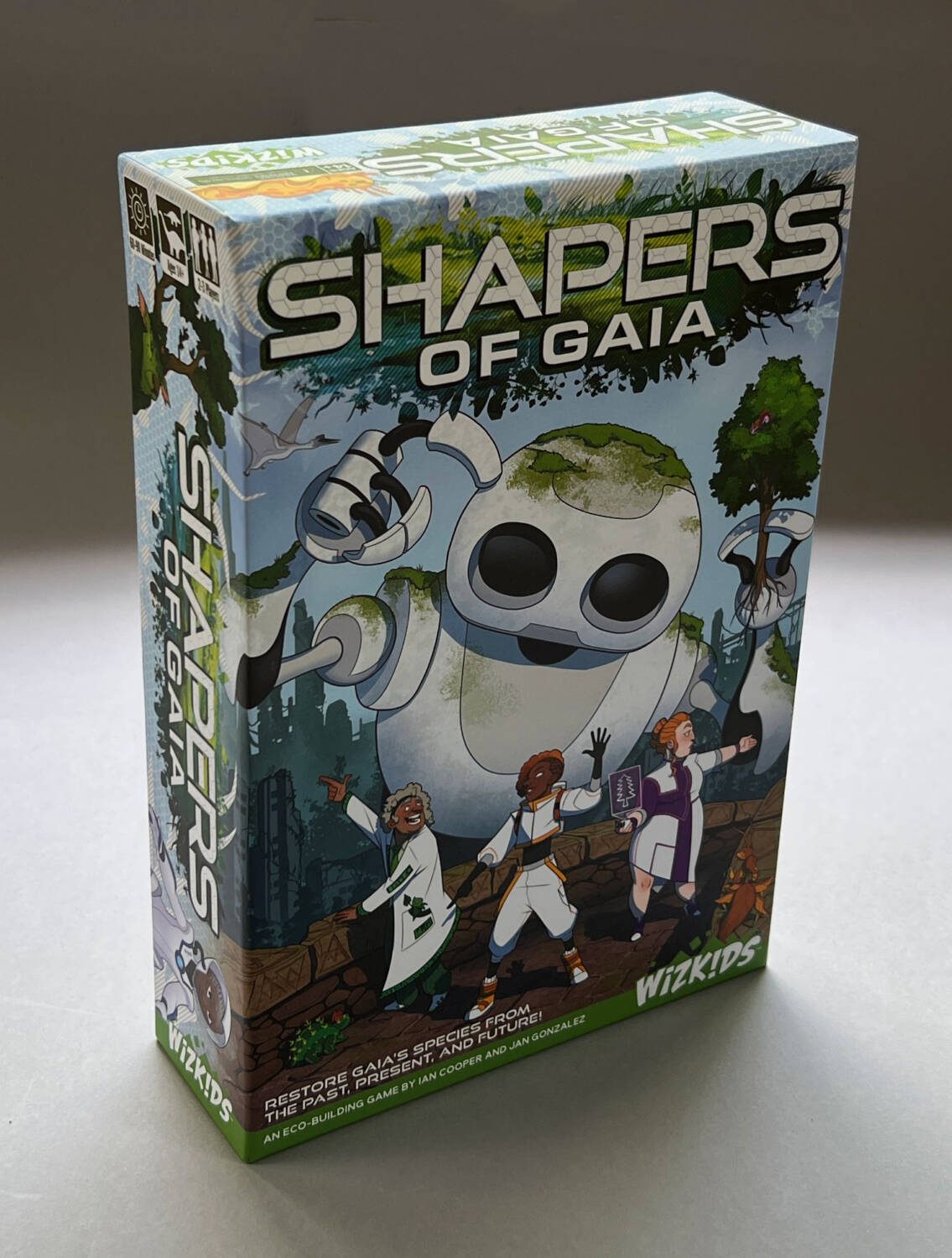
Setup
Place the hexagonal common board in the center of the table so it’s accessible by all players. Place the Vault tile in the center of the board, followed by the three starting water tiles, placed along the edges of the Vault hex tile such that there are spaces between each tile. Randomly place the three starting biome tiles in the gaps between the water tiles. Then place the green Caretaker on the water tile with the caretaker icon.
Separate the biome hex tiles based on the number on the back (I, II, and III) and shuffle each set of numbered tiles separately. Place the III tiles face down on the tile icon on the board, then place the II tiles atop those. Finally, place the I tiles on top of the stack. Then deal three I tiles to each player.
Randomly place the blue, yellow, and red triangular DNA tokens on the hexes at the edge of the board.
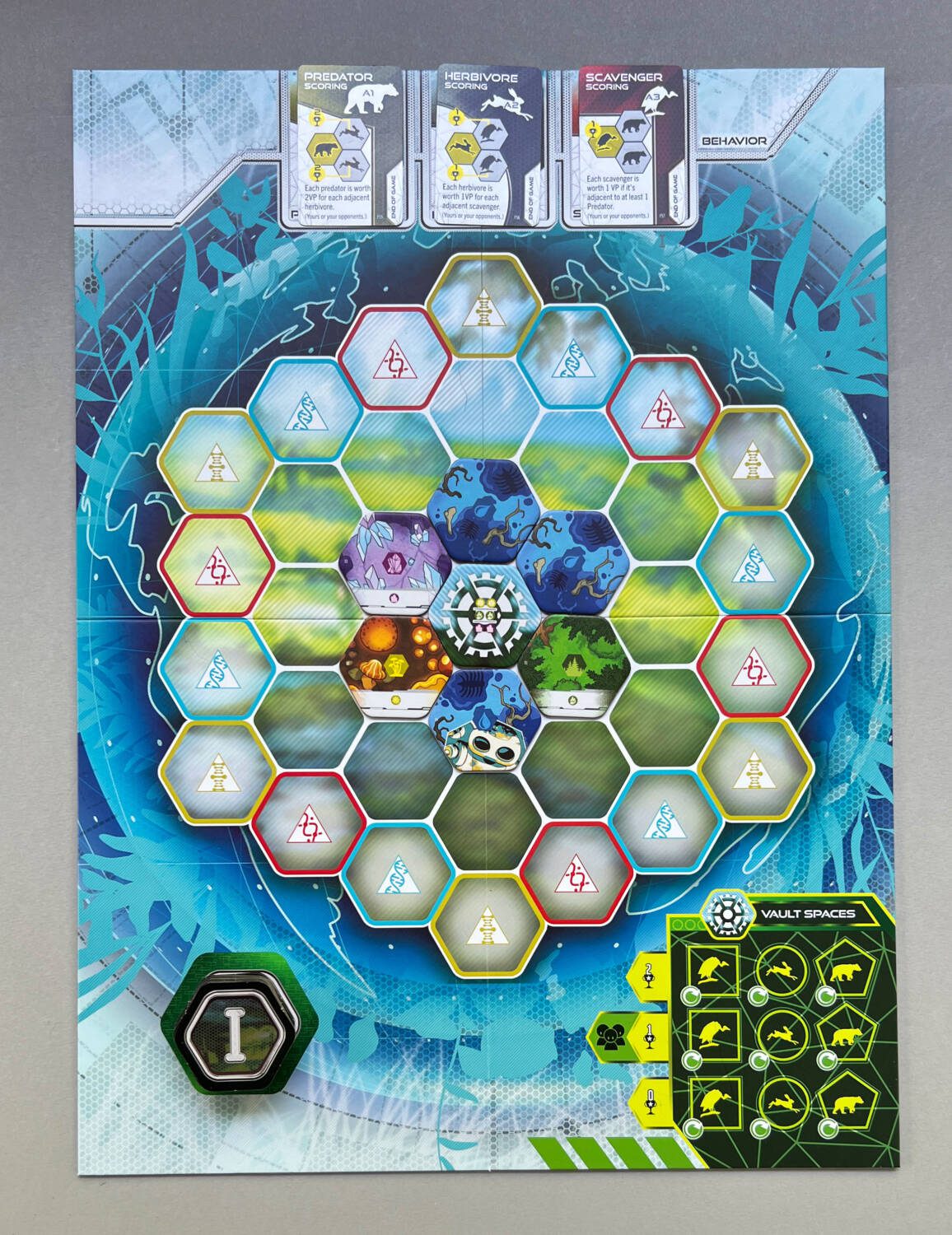
Sort the Species cards by type, Scavenger, Herbivore, Predator, and shuffle each deck. Place each at the top of the board and reveal the top two cards, with the third card being the one at the top of the deck.
Choose one of each of the Behavior cards and place them at the top of the board. These will be used for end game scoring.
Give each player a player board and have them place the wooden animal blocks of their chosen color (white, black, wood) on the appropriately-shaped spaces. Place the appropriate number of Special Cards to the side of each player’s board for later use.
Each player then gets a Resource track and a marker for each of the five resources: Crystals, Mushrooms, Seeds, Energy, and Nutrients. Place all markers along the 1 space.
And now you’re ready to play.
Shaping Gaia
Players can choose one of two actions on a turn: restore a biome or add an animal to an existing biome.
To restore a biome, take one of the biome tiles in your hand and place it on the board such that the new hex tile is touching at least two other hex tiles and the new tile is adjacent to the Caretaker robot. (If the Caretaker isn’t adjacent to the location you want to use, you can spend one Energy to teleport the Caretaker.)
After placing your tile, move the Caretaker on top of the tile and then resolve the tile.
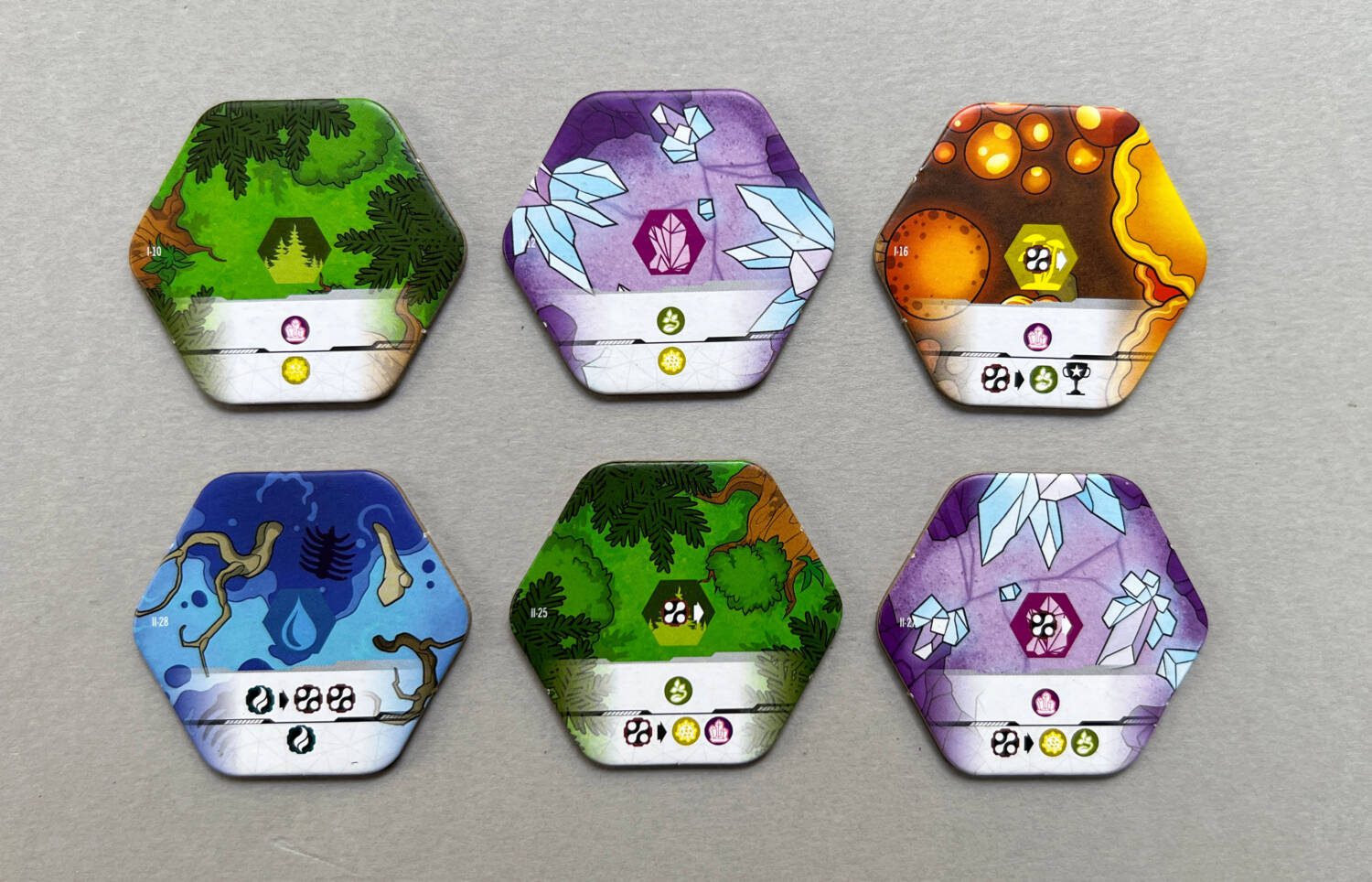
At the bottom of each tile, there are two actions. When you place a tile, you choose which option you’d like to take for yourself and which action your opponents will have the option to take. In the image above, the upper left tile asks you to choose between adding a Crystal or a Spore to your player board. You’ll take one; your opponents will take the other.
Finally, if your tile is placed on a tile along the outer rim of the board, you’ll need to take the triangular DNA token on that tile. More on this shortly.
You can play one, two, or all three of your biomes on a single turn if you wish. At the end of that turn, draw back up to three tiles from the stack of biome tiles on the common board. When placing an animal, you’ll first need to move your Shaper meeple to the tile you wish to place an animal on. Shapers can only move up to three spaces—or you can spend one Energy to teleport your Shaper.
Your player board will have ten animals, divided into Scavengers, Herbivores, and Predators. In order to place an animal you’ll have to have enough of that icon on your resource board to spend. For instance, if you want to place an animal on a Mushroom tile, you’ll need to see how many of that icon you have on your resource board. If you have four, you’ll be able to place any of the animals that have a 1-4 on the left side of the board.
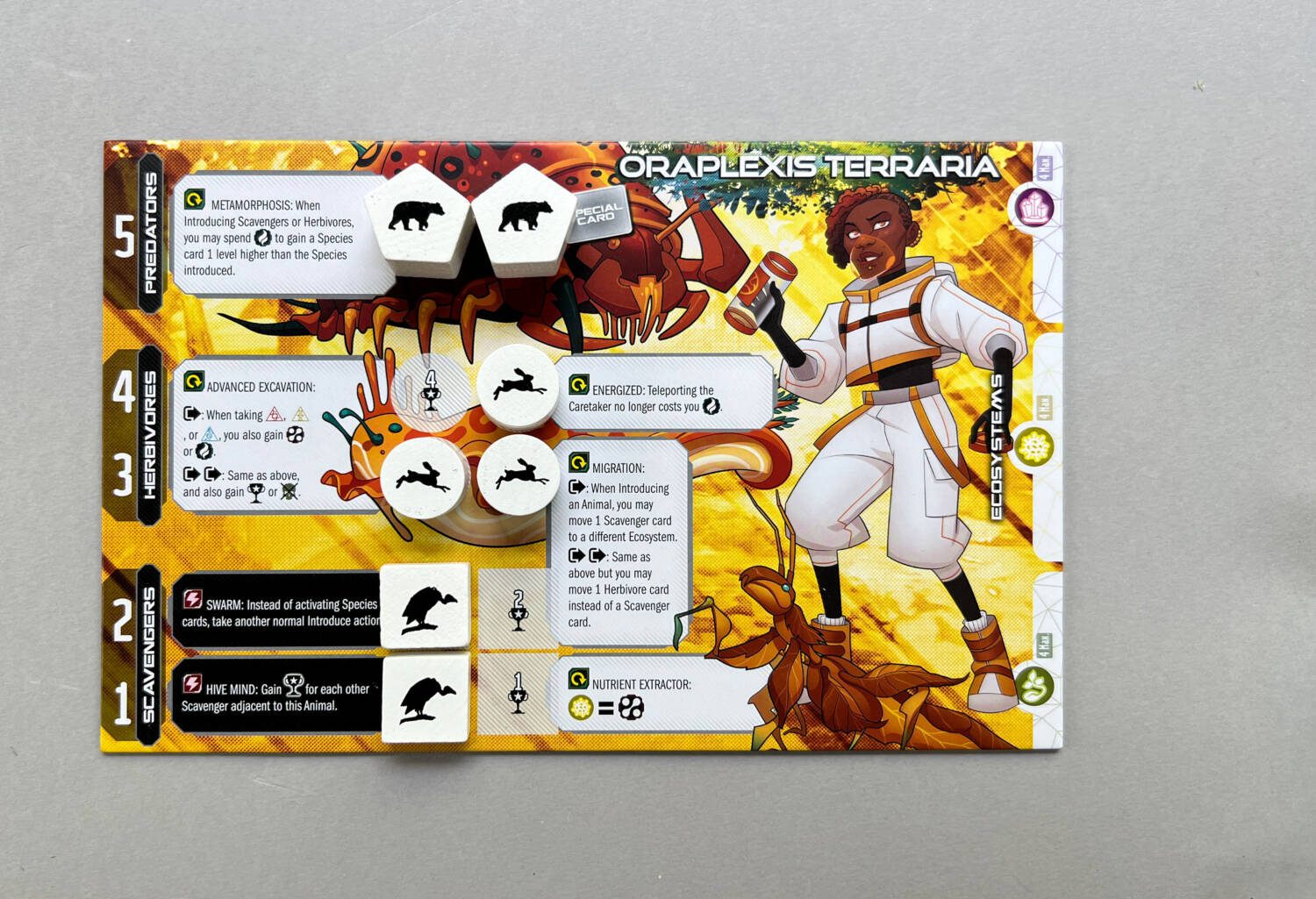
Placing an animal will always unlock a special power. Some are one-time actions, others are ongoing powers. Each board will have one or more powers that extend into two animals. With these, there is a top and a bottom power. Add the first animal and you’ve unlocked the first topmost power; add the second animal and you’ll unlock the bottom power.
Underneath each animal is a corresponding number of Prestige (Victory) points.
After placing an animal, you’ll look at the matching Species Cards along the top of the board. From the three face up cards you’ll choose one. Each of these will grant a resource or allow you to trade one resource for another—or several others. Place this to the right of your player board, matching the center icon on the tile you placed your animal. Then activate all the cards in that row. After placing your first animal, you’ll only activate that same card; for subsequent cards in that same row, you’ll activate all of them.
Remember those triangular DNA markers? Each of your Species cards will have a similar DNA triangle in their upper right corner. You’ll want to collect matching Species cards/DNA tokens because each matching set will earn you points. Any unmatched DNA tokens will cost you points.
Play continues in this way until either all the biome tiles have been taken from the stack, or one player only has a single type of animal left on their player board.
Thoughts
If much of this sounds familiar, you’ve likely played Seastead (reviewed here by fellow Meeple Mountaineer, Tyler Williams). Seastead is another game by designer Jan M. Gonzalez, with artwork by Ian Cooper, the same team behind Shapers of Gaia. Although I have not played Seastead, I’ve seen and read enough to know the two games are quite similar.
Let’s start with the positives:
Cooper’s artwork on the different faction boards is just cartoon-y enough to keep the notion of Scavengers and Carnivores from being too scary to younger players.

Each faction is unique, with the artwork conveying the dominant themes of each faction’s approach to reestablishing Gaia. When playing as each different faction, there are new decisions to be made. As a sign of how well balanced they are, each game we played saw the winning score being within a few points of the other two players.
So, given all this, I’ll return to the question I posed in the header: What’s not to like?
Unfortunately, quite a bit, as it turns out.
To start, I will say that I found Shapers of Gaia to be a Decidedly Okay game. It’s Fine. Nothing too negative, but also nothing too different or outstanding. While my gaming group liked it enough to ask that we play it several weeks in a row, I felt I’d gotten all I was going to get out of it part way through my second play.
The gameplay had enough decisions to keep me engaged, but once I understood the mechanics, I was left wanting more from the game. Take the top tile option or the bottom one, collect and spend resources, place animals to gain points and special powers that I didn’t find all that special.
Add to that, the small board and the limited number of tiles made the game feel small and restrictive. But was that really all?
Thinking about it, I realized there were a few other things that were bothering me. First, the player count is from 2-3 players, not 2-4. I’m not sure why they didn’t make the board a bit bigger to accommodate a fourth player. There were certainly enough player boards and by adding another row of hexes to the outer edge of the board (and extra tiles to fill them in) would have allowed for a fourth player.
There’s a big deal made about the individual player boards’ special cards that can be unlocked by placing the right Species on a tile. None of them seemed all that special, to be honest. Perhaps nice to have, but none of them were game-changers.
The setup instructions called for placing special End of Game scoring condition cards, one per Species type, at the top of the board. I had to look twice for them—there were only three, one double-sided card per Species type. Really? End of game scoring conditions should be important goals to be working towards during the game. To only have two per Species felt like this mechanism was little more than an afterthought. A very minor afterthought at that.
Then there’s the resource board.
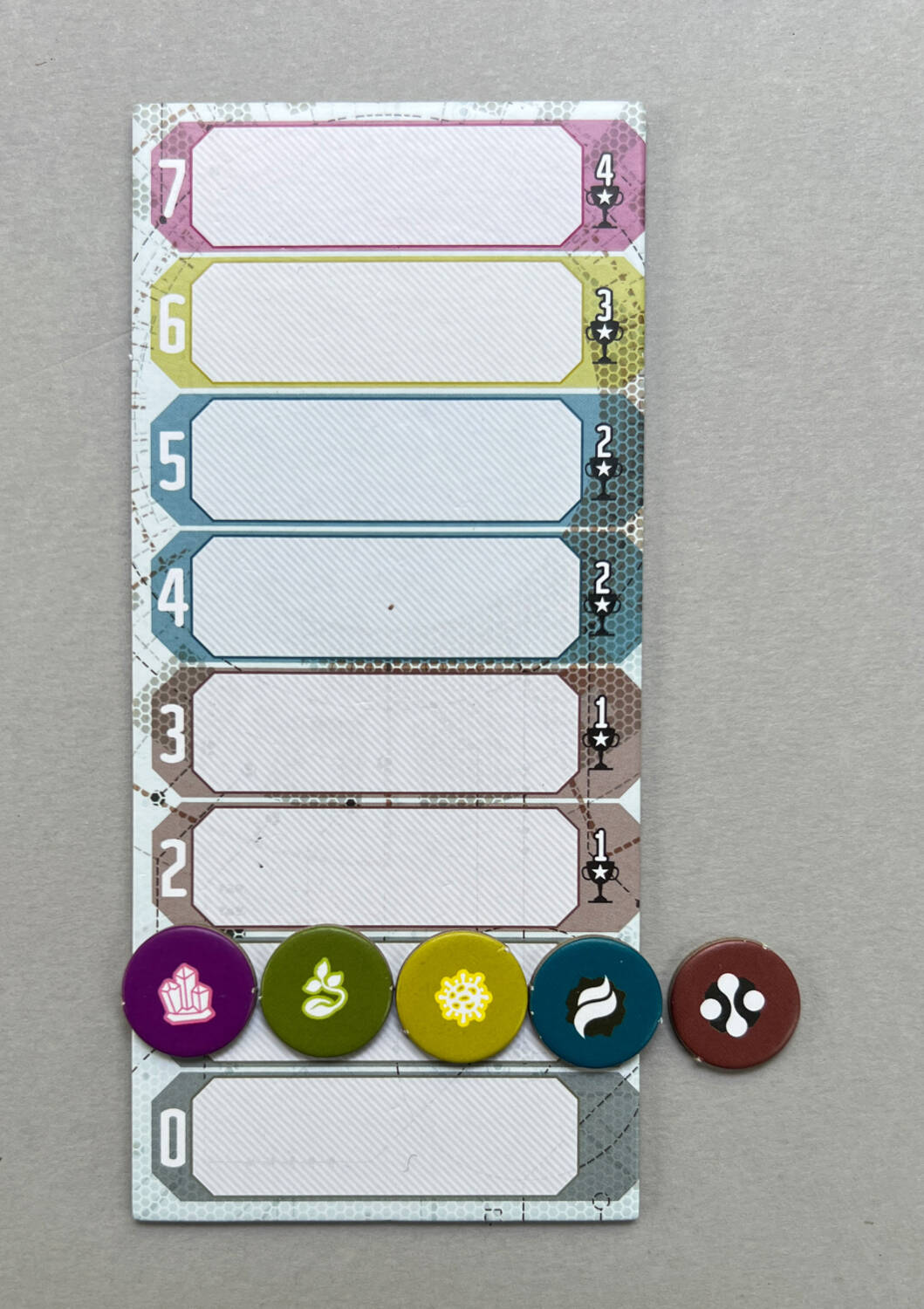
If you know all the resources are going to start on the same line, you should make the resource board wide enough to fit them all.
I understand if some people think these negatives are minor. As someone who plays a lot of different games for Meeple Mountain reviews, these things add up. I can tell when someone has put true effort, energy, and love into their game design. The game flows well, is chock-full of interesting, agonizing decisions, and makes you think about them long after the game components have been put away and the box replaced on your shelf. I did not get that feeling here.
Would I play Shapers of Gaia again? If someone really wanted to, I suppose so. However, I’d ask them why they wanted to play, discover which mechanisms they liked, and then point them to other games in my collection I think they would like better.







